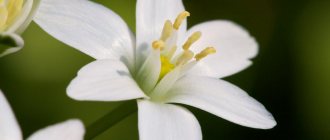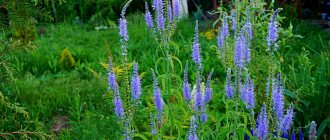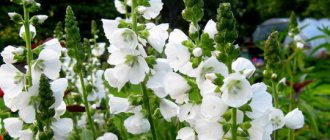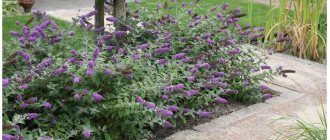Narcissists are very diverse. They are usually divided into 12 varietal groups. Let's find out what is their difference.
About 70 species of daffodils are known all over the world, and breeding work does not stop. Already in the 19th century, thanks to the breeding of hybrids, the number of varieties approached 30 thousand, but today no more than 2 thousand are grown. Among them there are both dwarf plants (up to 15 cm in height) and ordinary (classic) ones, which grow up to 60 cm in height. But the main distinguishing feature of daffodil varieties is the shape and color of the flower.
Trumpet daffodils
On each narcissus peduncle (from 15 to 45 cm in height), only one flower blooms, and the length of its tube is equal to the length of the petals or slightly longer than them. Flowers are most often white or yellow.
Popular varieties:
- Glacier (white with white tube),
- Golden Harvest (yellow with yellow tube),
- Dutch Master (bright yellow),
- Magnet (white with yellow tube),
- Mount Hood (white with pale yellow tube),
- Spelbinder (yellow with an almost white tube).
Large-cupped daffodils
One flower also blooms on the peduncle, but the length of its smooth or corrugated crown is more than 1∕3 the length of the petals. This group presents the most diverse combination of crown and perianth lobe colors. There are many varieties with an attractive border of orange, pink or red.
Popular varieties:
- Velazquez (cream with a huge orange crown),
- Carlton (yellow with a darker yellow crown),
- China Made (white with a white crown and bright yellow border),
- Debutant (white with pink crown),
- Flower Record (snow-white, yellow crown with orange border),
- Ice Follies (white with yellow crown),
- Kispruf (apricot with orange crown),
- Confuoco (yellow with a bright red crown),
- Paola Veronese (white, orange crown with a yellow tint),
- Passional (cream, pale red crown with a darker cream shade),
- Professor Einstein (snow white with red crown),
- Rosie Sunrise (white with pale yellow crown),
- Scarlet O'Xapa (yellow with red crown).
Small-cupped daffodils
In these single flowers, the length of the crown is less than 1∕3 the length of the petals. Most small-crowned daffodils have white, yellow or cream-colored petals, and the crown can be yellow-orange, apricot, pink, red or greenish, often with a darker border.
Small-crowned daffodils bloom later than plants from the first and second groups, but they are highly valued for their abundant flowering, rapid growth and delicate aroma of flowers.
Popular varieties:
- Amor (white with a large orange-red crown),
- Audibon (white with creamy pink crown),
- Rockall (white with red crown),
- Edward Buxton (yellow with a greenish-yellow crown and orange border).
"Anti-stress" area
A suitable growing location is the key to lush flowering of daffodils. Wrong choice of site leads to plant stress. Daffodils can tolerate shade, but bloom more profusely in a well-lit location.
Any soil will do, but it must contain clay. It is also desirable that the soil contains a minimum of peat and lime. The ideal option is soil with a neutral reaction (6.5-7 pH).
You also need to take into account that daffodils are moisture-loving, but stagnation of water can lead to rotting of the roots.
Double daffodils (Double)
These daffodils are different from the familiar flowers that we are used to seeing in flower beds. On the peduncle there are one or several flowers with a double perianth or a double crown. Or both options can be combined - such plants look very impressive.
Double daffodils can be one or two colors. Varieties of white and yellow flowers, as well as white with a red crown, have become widespread.
However, these incredibly beautiful plants have a significant drawback: when they get wet (after rain or heavy watering), the flowers droop and often break off.
Popular varieties:
- Akropolis (white with red residual crown),
- Outer Space (white with a terry pink crown),
- Chirfulness (white),
- Flower Drift (white with orange crown),
- Golden Dukat (bright yellow),
- Tahiti (yellow with red crown),
- Texas (yellow with an orange tint).
How to provide favorable conditions for flowering
In order for daffodils in the garden to bloom magnificently and amicably, they should be fed several times. During the season, it is recommended to do several feedings:
- The first fertilizing should be done after the first shoots appear. You should take any mineral fertilizer (30 g per 1 square meter), dilute it in water and fertilize the green sprouts;
- the second fertilizer is recommended to be applied during the budding of the bush (20 g per 1 square meter); the third feeding should be carried out after flowering. For this you will need phosphorus and potassium fertilizers.
The rest of plant care consists of removing weeds, slightly loosening the soil and regularly watering the flowers. It is recommended to water them from below, without touching the leaves and especially the flower.
Triandrus daffodils
Two or more drooping flowers bloom on a low peduncle (about 25 cm), with the perianth lobes slightly thrown back. The color of the flowers can be white, yellow or golden.
Popular varieties:
- Ice Wings (snow-white with a large crown),
- Waist (white),
- Tresemble (yellow),
- Hawera (lemon yellow).
Show more
Show more
Edelweiss, beauty from the rocky mountains
This content was published on August 17, 2022 August 17, 2017 The fluffy whitish stars of edelweiss flowers are a lucky find for tourists and a typical symbol of Swiss overseas marketing.
Cyclamenoid daffodils (Cyclamineus)
These daffodils have perianth lobes that are strongly bent back and have a narrow and very long crown (its length can exceed the length of the perianth lobes). The flowers are usually single, drooping, 6-8 cm in diameter. Plant height is 15-25 cm.
Popular varieties:
- Jenny (light cream with darker crown),
- Jetfire (bright yellow with a corrugated orange crown),
- Cotinga (white with apricot-pink crown),
- Tête-à-tête (yellow with orange crown).
Jonquillia daffodils (Jonquilla)
On one peduncle (15-30 cm high) 2 to 6 small flowers bloom (sometimes with rounded petals, slightly bent back, and a small cup-shaped crown. As a rule, its width is greater than its length. The flowers emit a rich, pleasant aroma. Color petals - white or yellow.
with rounded petals, slightly bent back, and a small cup-shaped crown. As a rule, its width is greater than its length. The flowers emit a rich, pleasant aroma. Color petals - white or yellow.
Popular varieties:
- Golden Smile (bright yellow with a wavy crown),
- San Disk (yellow),
- Step Forward (yellow with a lighter crown),
- Susie (golden yellow with orange crown).
Digging and replanting
Daffodils can grow in one place for 3 to 10 years. When the planted bulb has grown overgrown with children and turned into a large bush, but it begins to bloom poorly or has stopped blooming altogether, a transplant is performed.
It is recommended to dig up and replant daffodil bulbs annually if the site is located on peat soils, because in such conditions, by the spring of the second year, the bulbs may be so deep that they will not produce flowers.
Also, every year some gardeners replant double and trumpet varieties of daffodils, so they better preserve varietal characteristics.
Digging up the bulbs begins as soon as the daffodils' leaves dry out (usually this happens in July). Then they are dried for three weeks, thoroughly cleaned of soil and old roots and stored until planting. Store the bulbs indoors, dry, well ventilated and not too hot.
If you have already prepared a place for daffodils, you can plant them immediately after digging them up, without drying or removing the roots. They will tolerate such a transplant perfectly even during flowering.
Tazetta, or multi-flowered daffodils (Tazetta, Bunch-flowered)
On a strong thick peduncle (15-45 cm high) 2 to 8 medium-sized flowers with a rich aroma are formed. Their petals are round in shape and white in color; their crown is short, glass-shaped, yellow or orange. Tatset daffodils are afraid of the cold, so they are most often used for forcing.
Popular varieties:
- Horace (white with a dark yellow crown and red border),
- Yorlischer (white-yellow, terry),
- Geranium (white with a bright orange crown),
- Minnow (cream with yellow crown).
Selection of bulbs for growing
In order for the plant to quickly and easily adapt to indoor conditions, it is necessary to select large, hard bulbs for planting. They should not have defects: dark spots, scratches, holes, rot. It is better to immediately plant flower bulbs purchased for indoor growing in pots. If you need to store the bulbs somewhere before planting, then choose a ventilated room where it is dry and warm, since in a damp and cool place the bulbs can take root ahead of time or be affected by fungus.
Poetic daffodils (Poeticus)
Poetic daffodils are attractive with their rich aroma. They have single, drooping flowers up to 6 cm in diameter. The perianth lobes are most often milky or white, and the crown is flat, yellow with a red border. The height of the peduncles is 30-45 cm.
Popular varieties:
- Actaea (white with a greenish-yellow crown and an orange-red border around the edge),
- Milan (white with lemon yellow crown),
- Red Rome (white with a yellow crown and a wide red border on it).
Mr. Summer Resident warns: diseases and pests of indoor daffodils
When growing flowers, you can face many problems. Among them, the most common are the following:
- Fusarium fungus infection occurs with abundant watering, excess ammonia fertilizers, and keeping the bulbs warm and damp. To prevent disease, they need to be properly maintained and treated with fungicides before each planting. If a disease is present, plants and bulbs are discarded and destroyed.
- The large daffodil fly lays its eggs in the roots. Larvae emerge from them, feeding on the pulp of the onions and causing them to rot. To identify them, you need to press on the root; it should not be pressed at the top. The infected material should be treated with karbofos or kept in a pan of hot water for a couple of hours, maintaining the temperature no higher than +43 °C.
- Bulb aphids appear under dry scales and feed on the juices of rhizomes. This softens it, makes the plant sluggish, and impairs flowering. To eliminate the parasite, heat treatment in hot water is necessary, as is the case with a fly.
- Gray rot (botrythiosis) affects the leaves, leaving silvery and brown spots on them, then penetrates the rhizomes. Fungal spores develop when the air is over-humidified. To combat, 2 times a month, the infected areas are sprayed with 1-1.5% Bordeaux mixture, 0.5% captan solution or a copper-soap mixture (2 g of copper sulfate and 20 g of green soap). The roots are treated with 0.2% foundationazole.
- The onion mite lives in the soil and enters the bulb through damage. Plant growth stops, flowers and leaves wither. Damaged onions should be removed, healthy ones should be treated with heat.
- Nematodes feed on the juices of leaves and peduncles, from which they move into rhizomes. They combat it by heat treatment with water +40…+50 °C, into which the material is immersed for some time.
Infection often occurs due to insufficiently disinfected soil collected in the garden. In this case, sanitary treatment of the substrate will be required. In addition, to prevent narcissist diseases, you should adhere to the following rules:
- regularly loosen the soil and promptly remove dry and limp leaves;
- prevent soil waterlogging by creating drainage and balanced watering;
- create optimal conditions for planting material, store it at a temperature not exceeding +10 °C.
If you take all this into account, you can avoid many problems with growing daffodils. And then a blooming window sill will delight the eye for more than one day.
Wild species of daffodils (Bulbocodium Hybrids)
This group includes all cultivated species, forms and natural hybrids of wild daffodils. The height of such plants is no more than 20 cm. As a rule, they bloom very early.
Popular types:
- Narcissus Asturias, or small (its yellow flowers are shaped like tubular daffodils),
- Narcissus brandulidum (with narrow yellow petals and a yellow funnel-shaped crown),
- daffodil grooved (with white flowers and a yellow crown, like tacetas),
- daffodil enveloped (with small tubular flowers of golden color).
Planting in early spring
This option also has the right to exist. Therefore, before you start planting a plant, you should pay attention to the soil - it must be carefully dug up to the depth of a spade bayonet.
After planting the Daffodil bulbs, it is recommended to mulch the soil. Hardwood sawdust, nut shells, grass clippings, and chopped straw may be suitable for this purpose.
Mulching will help get rid of weed germination, retain moisture in the soil longer, and save you from early spring frosts.
Split-corona daffodils
In these daffodils, the upper part of the crown is divided (as if cut) into separate segments. At the same time, the edges of the crown (sometimes also the petals) are fringed.
There are 2 forms of split-crowned daffodils:
- split-corona - the crown segments are located opposite the petals and are usually pressed against them;
- papillon - a flower shaped like a butterfly.
Popular varieties:
- Baccarat (oval perianth lobes creamy yellow, crown dark yellow),
- Canasta (with white fragrant flowers),
- Malli (white daffodil with a bright salmon crown and a ruffled border around the edge of the petals),
- Orangerie (snow-white petals and bright orange wavy crown),
- Papillon Blanc (creamy white).











